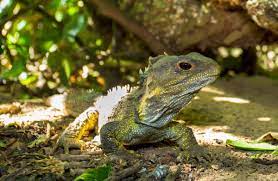In the remote corners of New Zealand, an ancient creature known as the tuatara (Sphenodon punctatus) dwells, defying time itself. This enigmatic reptile, often called a “living fossil,” has perplexed scientists with its unique features and remarkable history. Join us on a journey through 48 captivating facets of the tuatara as we unveil its fascinating biology, evolutionary significance, and its status as a true living relic.

1. Evolutionary Survivor: Tuataras are the last remnants of a once-diverse reptilian order.
2. Misleading Name: Despite their name, tuataras aren’t true lizards.
3. Slow Growers: They have one of the slowest growth rates among reptiles.
4. Ancient Ancestors: Tuataras have remained virtually unchanged for over 200 million years.
5. Third Eye Mystery: They possess a “parietal eye” on top of their head, which detects light and regulates circadian rhythms.
6. Unique Dentition: Tuataras have two rows of teeth on their upper jaw and one on the lower, ideal for grasping prey.
7. Cold-Blooded Survivors: Tuataras are ectothermic, relying on external sources for temperature regulation.
8. Geographical Isolation: Restricted to New Zealand, tuataras highlight the importance of island ecosystems.
9. Lifespan Enigma: They can live up to 100 years, outliving most reptiles.
10. Slow Metabolism: Tuataras are known for their leisurely pace of life.
11. Reproductive Oddities: They have a unique mating behavior called “cloacal kissing.”
12. Age Record: The oldest known tuatara lived to be 111 years old.
13. Island Biodiversity: New Zealand’s isolation led to a diverse range of species, including the tuatara.
14. Conservation Challenges: Habitat loss and introduced predators threaten their survival.
15. Iguanian Ancestry: Tuataras belong to the same order as iguanas, yet they diverged over 200 million years ago.
16. Secretive Behavior: They are primarily nocturnal and elusive.
17. Vulnerable Offspring: Tuatara hatchlings face high predation rates.
18. Bizarre Courtship Calls: Males produce unusual sounds during courtship.
19. Living in Shadows: Tuataras prefer dark, concealed habitats.
20. Feeding Behavior: They are opportunistic carnivores, dining on insects and small prey.
21. Fossil Connections: Tuatara fossils have been found in New Zealand dating back to the dinosaur era.
22. Endemic Islands: Tuataras inhabit several New Zealand islands, each with its own unique population.
23. Conservation Icons: Tuataras are symbols of New Zealand’s conservation efforts.
24. Closely Watched: Researchers closely monitor tuatara populations due to their endangered status.
25. Reproductive Rarity: Female tuataras reproduce only every 2-5 years.
26. Unfused Bones: They retain a unique primitive feature where the skull’s bones remain unfused.
27. Living Relic: Tuataras offer a glimpse into the past, revealing the evolution of reptiles.
28. Cool Climate Creatures: They prefer cooler temperatures and are well-suited to New Zealand’s climate.
29. Basking Behavior: Tuataras occasionally bask in the sun to regulate body temperature.
30. Genetic Resilience: Their genetic diversity has been maintained over millions of years.
31. Ultra-Slow Breathers: Tuataras can go without taking a breath for up to an hour.
32. Prehistoric Palate: Their diet includes beetles, weta, and even seabird chicks.
33. Island Guardians: Tuataras play an important ecological role by controlling insect populations.
34. Myth and Legend: In Maori culture, tuataras are revered as spiritual beings.
35. Unique Blood Composition: They have a hybrid blood system with reptilian and avian characteristics.
36. Endothermic Abilities: In cooler temperatures, tuataras can exhibit limited endothermic behavior.
37. Ecological Interactions: Tuataras coexist with other unique New Zealand species.
38. Fragmented Habitat: Isolated populations face different challenges on separate islands.
39. Reproductive Tidbits: Tuataras don’t lay eggs; they give birth to live young.
40. International Interest: Tuataras attract researchers and conservationists worldwide.
41. Genetic Quirks: Tuatara genomes offer insights into reptile evolution.
42. Native Guardians: Maori tribes are deeply connected to tuatara conservation efforts.
43. Ecosystem Engineers: Their burrows provide homes for other species.
44. Slow Motion Mastery: Their slow metabolism is a remarkable adaptation.
45. Resilience in Isolation: New Zealand’s isolation has preserved unique ecosystems.
46. Living Time Capsules: Tuataras offer a living link to Earth’s distant past.
47. Iconic Species: Tuataras are a symbol of New Zealand’s natural heritage.
48. Guardians of the Past: These ancient reptiles remind us of the Earth’s incredible history.
Explore the enigmatic world of the tuatara, a living fossil that defies time, as we uncover its remarkable adaptations, evolutionary significance, and its role as a true relic of Earth’s ancient past.



















Add Comment